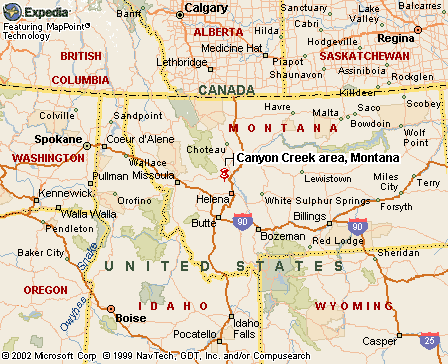|
|
Canku Ota |
|
|
(Many Paths) |
||
|
An Online Newsletter Celebrating Native America |
||
|
September 21, 2002 - Issue 70 |
||
|
|
||
|
Nez Perce Site Dedicated |
||
|
by Jim Gransbery of The
Billings Gazette Staff-September 15, 2002
|
||
|
credits:Larry Mayer/Gazette
Staff
Nez Perce singer Pete Wilson, of Lapwai, Idaho, sings a flag song to open a ceremony at the Canyon Creek Battlefield site north of Laurel Saturday morning. |
 NORTH
OF LAUREL - Under a hot sun Saturday, unlike the weather 125 years ago,
ground was blessed and broken to commemorate the site of a skirmish between
the Nez Perce bands fleeing to Canada and the forces of the U.S. Army. NORTH
OF LAUREL - Under a hot sun Saturday, unlike the weather 125 years ago,
ground was blessed and broken to commemorate the site of a skirmish between
the Nez Perce bands fleeing to Canada and the forces of the U.S. Army.
On Sept 13, 1877, U.S. Cavalry under the command to Col. Samuel Sturgis encountered the rear guard of the Nez Perce as they moved up Canyon Creek. It was a miserable day, wet and cold with heavy winds. Sturgis and his forces were attempting to intercept the Nez Perce, who had left their ancestral lands in Oregon and Idaho in July and had crossed through western Montana, eastern Idaho, Yellowstone Park into Wyoming and north again into Montana pursued by the forces of Gen. O.O. Howard, who had been ordered to force the Indians onto a much reduced reservation in central Idaho. The ceremony Saturday morning was to remember the killed and wounded on both sides and to begin the construction of an interpretive shelter, one of 38 sites along the national Nez Perce Trail that runs 1,700 miles from the Wallowa Valley in Oregon to the Bear's Paw Battlefield, south of Chinook. "This could be a model to use on other sites along the trail," said Julia Davis Wheeler, secretary of the Nez Perce Tribe in Lapwai, Idaho. "I want to remember today especially the women and children who were here," she said. "Coming over we were complaining that it took a whole day (600 miles) to get here. For our ancestors it took days and days and days." Wheeler then asked that the ground be blessed before it was broken so that "all the good feelings here carry over." Charlie Axtell, a pipe carrier for the tribe, in a short ceremony sang a healing song so that "all would be mindful of their way of life and the well-being of all peoples." The blessing was performed by Wilfred Scott who called on the Creator to protect all there. He then blew notes from a eagle-bone whistle to the four points of the wind. The project to place an interpretive center at the site was initiated in the mid-1950s by the Friends of Canyon Creek who placed a stone marker in 1958 at the intersection of Lipp and Buffalo Trail roads just before it winds into Canyon Creek. Milt Wester, publisher of the Laurel Outlook and president of the Friends of Canyon Creek, hosted the ground-breaking event attended by about 100 people. Representatives of the National Park Service, Yellowstone County and the Yellowstone Historic Society were on hand. Wester said that "we are very lucky people to be in this place which is not too much different from 125 years ago." Rich Pittsley, of the Yellowstone Historic Society who has been instrumental in the preservation of other historical sites in the county, in a prepared speech said, "Our shared heritage is defined by the locations that bring us together, today in a sense of peace and healing. This location is hallowed ground. The soil is mixed with the blood and tears of those who came before us." He paid homage to the Nez Perce, the 7th Cavalry, and the Crow, Shoshone, Blackfeet and Sioux, all of whom used the surrounding sandstone breaks as sites for prayer, vision quests, and their way of life. He also recognized the homesteaders, cattlemen and sheepmen who put their lives into the soil. "In the challenge of diverse cultures learning to live and work together harmoniously, this healing place is important," Pittsley said. Several people took part in the ground-breaking including a descendant of Chief Joseph. Agnes Broncheau, of Spokane, related to Joseph on her mother's side of the family, turned a shovel of dirt at the site. Later, the Nez Perce hosted a Pipe Ceremony, which was opened with the presentation of the U.S. and Nez Perce flags and eagle-feathered coup sticks. A rifle squad and flag bearers from the Laurel VFW Post took part. The entrance song was the flag song of the Nez Perce that members of Looking Glass's band sang in 1855 during the Walla Walla treaty talks that set the original boundaries of the lands of the Umatilla, Yakima and Nez Perce tribes.
|
|
|
||
|
|
||
| Canku Ota is a free Newsletter celebrating Native America, its traditions and accomplishments . We do not provide subscriber or visitor names to anyone. Some articles presented in Canku Ota may contain copyright material. We have received appropriate permissions for republishing any articles. Material appearing here is distributed without profit or monetary gain to those who have expressed an interest. This is in accordance with Title 17 U.S.C. section 107. | ||
|
Canku Ota is a copyright © 2000, 2001, 2002 of Vicki Lockard and Paul Barry. |
||
 |
 |
|
|
The "Canku Ota - A Newsletter Celebrating Native America" web site and its design is the |
||
|
Copyright © 1999, 2000, 2001, 2002 of Paul C. Barry. |
||
|
All Rights Reserved. |
||
